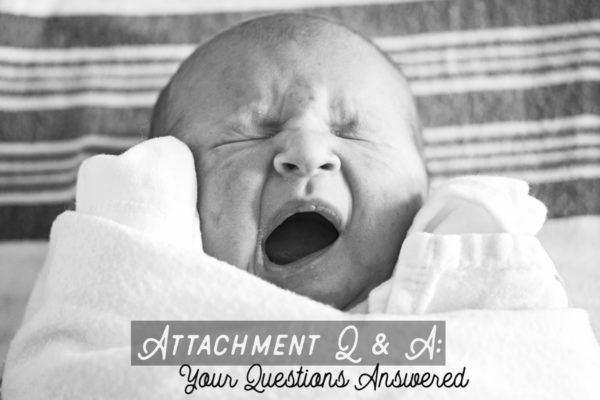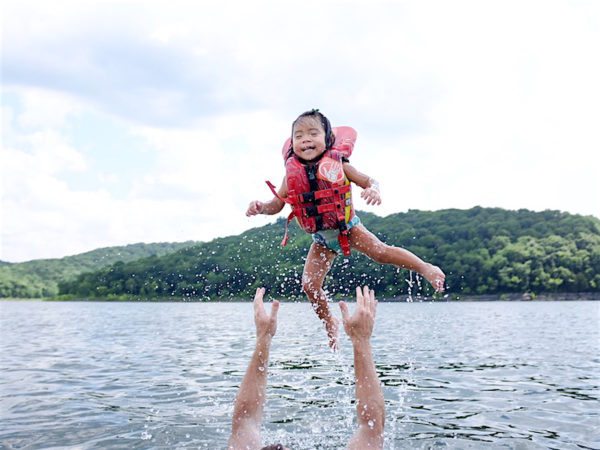Attachment. Not much more could not be packed into one single word, especially in the adoption world.
We spent all of July focusing on this most-important topic and decided to continue into August – but with a bit of a twist.
This month, we’re answering your attachment questions. Because we all have them – we just don’t always have a safe place to ask.

Question: Is there a way to guard against unattachment? What are some ways to reattach if unattachment happens?
The imagination I possess cannot conjure anything but terror. My palms sweat a little even as I think about the bold step of falling out of an airplane far above the earth and rushing with the wind toward an unforgiving surface. Even so, we willingly entered a freefall, joining the little girl we had pursued, one brutally cold January day in an overheated office building on the other side of the world.
Her fall had not been asked for; it had not been on her bucket list. Her descent was abrupt as she was torn from the family she was born into and placed for care with the only people who were able to help her. Falling freely, she struggled a bit with her transition, and then adjusted to the wind whipping past her face, the schedule of bottles and diaper changes, lights on, lights off. As the faces who leaned over the rails of her crib rotated in and out, she learned to distance herself from the smiles she saw; the safest form of freefall she could create for herself at such a young age. She observed, she watched, she figured out over time how to work with the gusts of wind around her.
Terror? The imagination I possess tells me I would feel terrified in her place. And yet, by the time we arrived on her scene, with the hope of a gentle landing in her future, she was quite accustomed her to rapid descent. Our outstretched arms seemed foreign, undesirable. Our hopeful faces were just more in a long line of faces she sought to distance herself from.
For her, the terror wasn’t in the freefall; it was in the rescue.
“Safe” was the only thing she knew nothing about, and everything inside of her rebelled against this family she had no frame of reference for. We committed to holding her close no matter what the cost. Even when she fought to free herself from us we clung tight, knowing that falling together was what families do.
Fast forward, and the journey seems less dramatic most days. Most days. Most days we are typical, or at least as typical as we’re going to get! The siblings argue, the siblings play. The dinner is devoured by a few, while another few turn up their little noses and declare they don’t care for vegetables. School supplies for a new year are purchased, birthdays are celebrated, vacations are enjoyed. And yet, without warning, we have days when it feels like we’re in freefall again; days when I look at my husband’s eyes, wide open like mine, and we whisper that feels like the beginning all over again.
It strikes us harder in these moments, now that we’ve experienced what “typical” can feel like. The scars that have been healing slowly over time seem to tear open a bit and bleed a little more than we are comfortable with. If truth is told, it’s a little more frustrating when the attachment we’ve worked so hard at seems to disintegrate, leaving us feeling like the freefall might never end.
Our daughter does not have a Reactive Attachment Disorder diagnosis; we know that she can attach, albeit slowly, and with great care taken to be intentional on our part.
So why does it seem that she can “un-attach” in the most random of moments? Turns out it’s more about perspective than I first realized. Often the “un”-attach is something felt from my end of things when we experience a set-back or when something triggers her in a way that makes her feel like she’s not safe. By the grace of God, and the counsel of friends, and the help found with our family therapist, I have found hope knowing that it’s not a bad thing.
The moments when we feel the farthest from our children, attachment-wise, are the moments when there are the greatest opportunities to form a deeper attachment to them.
The cycle is called Rupture and Repair.
When we feel a break (rupture) in the attachment to our child, whether the break comes from their end or ours, it’s an opportunity. The options presented to us as parents in that moment are two-fold: we can either maintain and nurture the distance (hurt feelings, doubt, feeling like a failure, guilt, etc.) OR, we can repair the damage.
Choosing repair over continued rupture isn’t natural in many situations. In fact, it may feel like the very last thing you want to do. It may feel frustrating, especially if you have other children for whom the rupture/repair cycle flows a little more smoothly.
What has helped me to be more willing to step into the pain my daughter is feeling is recognizing that these moments are natural. They are what happen between every parent and child on the planet every day. Every parent-child relationship is filled with ruptures and subsequent repairs; it’s how a child starts to feel secure in their attachment. With our children from hard places? It just takes longer.
Sure, it’s frustrating to me when I see behaviors happening that I feel should have their place only in the past, it’s frustrating to know that my daughter doesn’t feel secure in that moment after all I have poured into her. It’s at that time when I have to choose to step into her shoes, to recognize in that particular moment in time the past is living in the present, and it is paralyzing her. In that moment, she needs to know that I am safe.

And so, I pursue her. I think about the things that she loves to do when I am with her, I hold her close if she will let me. I work a puzzle out with her, I sit down and have a snack with her while making as much eye contact as possible. Whatever I can do to start to heal the gap that has developed, I do it. I don’t always want to, the human side of me cries out that “enough is enough”, and yet, I cannot fathom letting her drift away.
She is mine. She worth fighting for, and so when she freefalls, I jump out with her, oblivious to the sweating of my palms telling me this is the most unnatural thing to do.
I cannot watch her fall alone.
As time passes, and the practice that happens with each repair occurs, the process seems to be a little smoother. There are still moments when I am wide-eyed and speechless, wondering what has happened to trigger the descent I am seeing.
Now, though? Now I just jump. I jump straight into the repair once the opportunity presents itself, and I choose gratitude for the chance to let the wounds of rupture heal; to let the scars be proof of the attachment we fight for.


























Leave a Reply